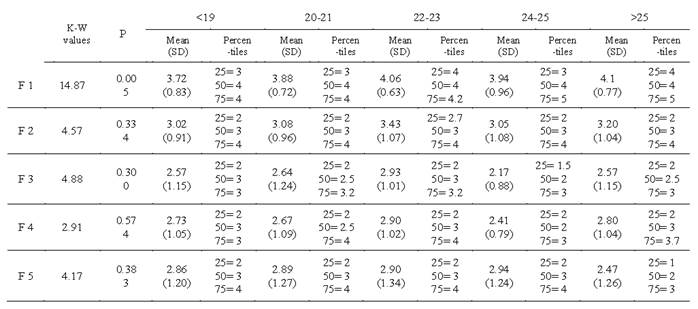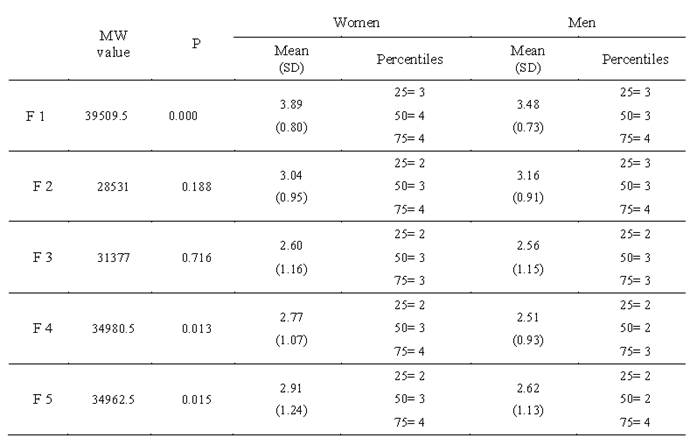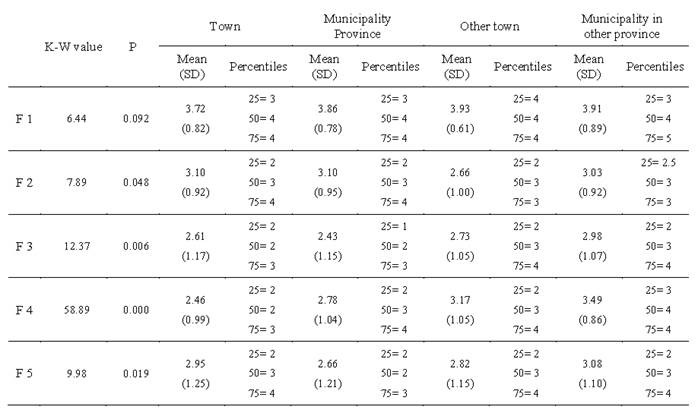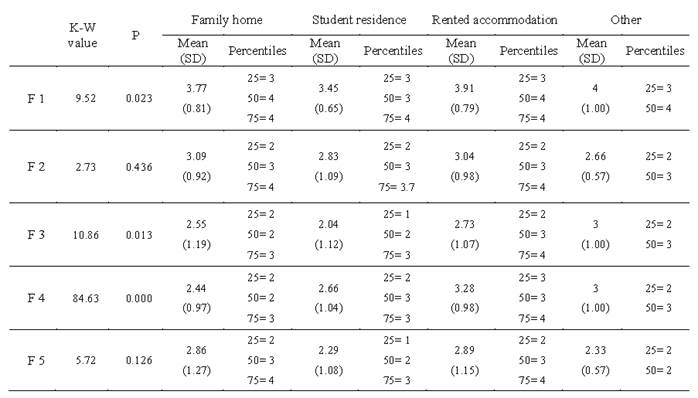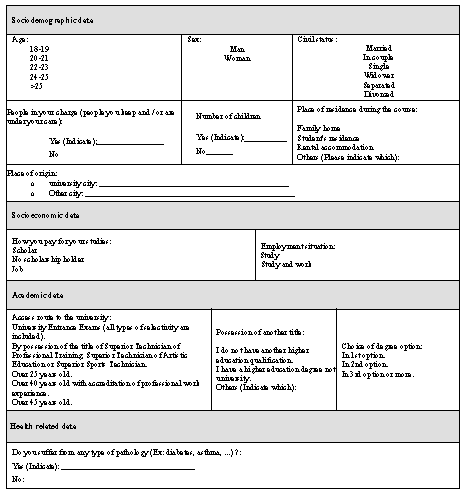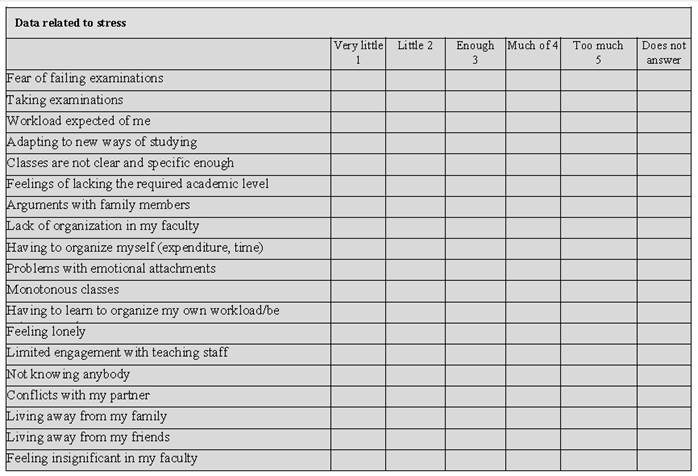Servicios Personalizados
Revista
Articulo
Links relacionados
Compartir
Enfermería: Cuidados Humanizados
versión impresa ISSN 1688-8375versión On-line ISSN 2393-6606
Enfermería (Montevideo) vol.10 no.1 Montevideo jun. 2021 Epub 01-Jun-2021
https://doi.org/10.22235/ech.v10i1.2300
Original Articles
Perceived stress factors among newcomers to the nursing career
1 Universidad de Huelva. España. juan.gonzalez@denf.uhu.es
Keywords: nursing students; stress; university; mentorship; education.
Palabras clave: estudiantes de enfermería; estrés; universidad; tutoría; educación.
Palavras-chave: estudantes de enfermagem; estresse; universidade; mentoria; educação.
Introduction
Stress was defined by Richard Lazarus and Folkman as a relationship between the person and the environment that is appraised by the person as taxing his or her resources and endangering his or her own well-being (1).
It is well documented that working in the nursing profession involves high levels of stress (2). In the case of nursing, there can be added the additional problems of an especially large academic load and the pressure of responsibility associated with carrying out one’s nursing duties in a clinical context. Such issues give rise to periods of very high stress for nursing students (3). Rayan (4) suggests that the stress experienced during their university training can have a significant impact on students’ emotional stability at the end of their degree. It is important, then, to prepare students to face up to stress from the start of their studies by helping them to regulate their emotional responses, and where possible to prevent it. This kind of preparation can also be of help to them regarding the challenges of their future professional life. In this respect, identifying the specific factors involved in stress among nursing undergraduates can be beneficial to the development of interventions and methodological strategies for helping students reduce the stress of their training period.
The aim of this study was to determine the stressors prevalent among incoming students in the Nursing Faculties of the Universities of Western Andalusia, and the influence of sociodemographic, academic, socioeconomic, orientation and health factors. Therefore, we described the sociodemographic, academic, socioeconomic and health profile of the participants; identified the most stressful situations and the most prevalent stressors; and related the most prevalent stressors to sociodemographic, academic, socioeconomic and health variables.
Background
Stress is an everyday feature of daily life and has been the object of a wide variety of multidisciplinary studies over the last few decades, as the reviews realized by Jamieson et al. (USA, 5), Ramírez et al. (México, 6) and Brosschot et al. (The Netherlands, 7). The most accepted theories postulate that some kind of stimulus, denominated the stressor, must be present in order to trigger a response or reaction expressed as stress (8-9). Hence we can define academic stress as the kind of stress produced in any educational context, especially the university context, affecting both teachers and students.
In this respect, Fisher notes that starting university, with all its attendant changes, represents a set of highly stressful situations. New students can experience a feeling of lack of control over their new surroundings, which has the potential to generate stress and (together with other factors) lead to academic underachievement. The period of initial adaptation to the university system can even last beyond the first year of study, with significant levels of stress detectable within just a few weeks of starting university (3).
Prolonged or high levels of stress can have a negative impact on learning, clinical and academic performance, physical and mental health, cognition and general wellbeing (3, 10- 11). It should be noted that there is significant scientific evidence that nursing students undergo higher levels of stress than students on other professional programmes, including medicine, social work and pharmacy (3). Salavarani et al (12) highlight an excessive workload as one of the main stress factors among trainee nurses. In the same vein, Cabanach et al (13) conclude that the most frequent elements of concern among nursing students are academic stress, workload, examinations, and fear of underachievement.
Given the intrinsically stressful nature of the educational process, students cannot rely purely on avoidance strategies, and must instead rely on their ability to manage stressful situations as they arise (3). Teaching students how to achieve good psychosocial adjustment, alongside the use of stress management techniques, can help them to cope with the kind of stressful situations which commonly occur at university, and likewise help them to prevent later problems, such as psychological distress or burn out (14). Hence, although starting a degree in nursing is undoubtedly a stressful life event, it could also be a unique opportunity to promote the acquisition of psychosocial strengths among students, and to develop in them the necessary skills for keeping themselves on track towards wellbeing and success (15-18). Safeguarding students’ mental health and promoting self-care are crucial to the future of the profession (19-21).
Method
Study design
A cross-sectional descriptive, observational, multicentric study was carried out during the academic year 2014-2015, with the aim of identifying the most frequent factors and situations of perceived stress among new students in Faculties of Nursing in western Andalusia.
Participants
Of a total of 645 students registered in the first year of the degree in Nursing at the western Andalusia, 617 participated in the study, giving a response rate of 95,66 %. The only reason for exclusion from the study was if a student was repeating the course.
Inclusion criteria
Students who enrolled in the first year of the Nursing Degree of the Faculties included during the academic year 2014-2015. Consent of voluntary participation in the study.
Exclusion criteria
Students who repeat first year subjects but who are also enrolled in other courses, that is, repeating students.
Description of the variables
In our work, we will focus primarily on stress variables perceived, although we will also consider sociodemographic variables, socioeconomic, academic and health.
-Sociodemographic variables: age, sex, marital status, dependents, number of children, place of origin and residence.
-Socioeconomic variables: way in which the studies are paid and the student's employment situation.
-Academic variables: access route to the university, possession of another degree and option of choice of the degree.
-Health-related variables: pathological history, if the student suffers from some type of disease or not.
-Stress-related variables: perceived stressors.
Data collection
Data was collected by means of two self-administered questionnaires, which students completed individually in the lecture rooms where they were taught, during the first semester of the academic year 2014-2015 (October to January). The course tutors gave instructions for filling in the form and were on hand to offer any assistance required. Students were informed that all data collected would be anonymised according to current data protection laws (consent was given verbally). The task was completed in approximately ten minutes.
Research tools
Ad hoc sociodemographic and health questionnaire
This form was devised by the researchers for the purpose of collecting students’ sociodemographic profile (items: age, sex, marital status, dependents, number of children, place of origin and residence.), along with academic (items: access route to the university, possession of another degree and option of choice of the degree), socioeconomic (items: way in which the studies are paid and the student's employment situation.) and health data (pathological history; Annexed 1).
Perceived stress questionnaire for new students
The questionnaire used for this purpose was a slightly modified version of the perceived stress questionnaire developed by Iglesias Parra (22) for first year students. The original version consisted of 17 items grouped into four categories of factors, but after a pilot study added the items “living away from my family” and “having to organise myself (spending, time)”, the version which was finally used contained 19 items (Annexed 1). In order to increase the likelihood of detecting potential relationships between factors, a factor analysis of the 19 items was carried out, pointing to the existence of five, rather than four, factors, to be able to respond to all the objectives. The inclusion of new items was done with the idea of being able to obtain more information about the situation, social relationships and support that the students had. The new factor was given the name “social support network”, and was added to the definitive list, thus: academic stress (factor 1); university disorganisation (factor 2); feelings of loneliness (factor 3); social support network (factor 4); and relationship problems (factor 5). Finally, the reliability of the questionnaire was calculated using Cronbach’s alpha (α= 0.859).
Data analysis
The data were first subjected to the standard descriptive statistical analysis of frequency, mean and standard deviation. This was followed by a differential analysis using non-parametric methods (Mann-Whitney U and Kruskal-Wallis tests) in order to identify the relationships between various features of the students such as age or sex. These analyses were carried out with SPSS 20.0 for Windows and Microsoft Excel. The significance level was set at p=0.05 for all analyses.
Ethical considerations
The rights of all participants in this study were guaranteed under the Nuremberg Declaration (Nuremberg Code) 1947, the Helsinki Declaration 1964-2000, the 2003 International ethical guidelines for health-related research involving humans (CIOMS), and the respective Spanish legislation (Royal Decree 1014/09) with the voluntary consent and the Bioethics Committee of the University of Huelva’ authorization.
Results
Characteristics of the participants
The majority of students in the study were women (79.7 %) under the age of 19 (64.2 %). 83.5 % of participants were studying in the same province as their home town, while 32.4 % were living in rented accommodation for the duration of the course.
A large majority (61.3 %) received some kind of grant or aid in respect of their studies, and only 4.1 % worked in order to pay the fees.
With respect to entry requirements for, 69.7 % had passed the university access examination, and 59.3 % had made a degree in Nursing their first choice of course.
A large number of students (60 %) attended the faculty welcome day, but only 13 % made use the tutorial system.
It can also be noted that in general the new students to nursing (82.5 %) were not suffering from any pathology prior to their enrolment in the degree.
Descriptive analysis of the factors and items in the questionnaire
Tables 1 and 2 show the analysis of the means obtained for the factors and items constituting the questionnaire. As can be seen, the new nursing students perceived the factor academic stress as the most significant (3.808), followed by university disorganisation (3.068), and relationship problems (2.852), whilst the factor feelings of loneliness was least identified with stress (2.594).
Table 2: Descriptive statistics for each item, in descending frequency, in the Perceived stress questionnaire for new students
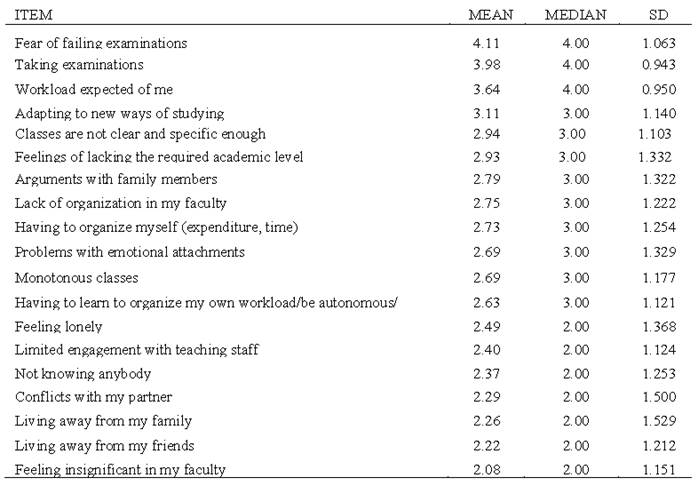
At the same time, the item most associated with stress was “fear of failing exams” (4.11), followed very closely by “taking exams” (3.98), and then by “workload” (3.64). Conversely, the least stressful item was “feeling anonymous in the faculty (2.08), followed by “living away from friends” (2.22).
Differential analysis of variables and stress factors
The variables age (Table 3), sex (Table 4), place of origin (Table 5) and place of term-time residence (Table 6) were found to be related to different stress factors in terms of the corresponding significant differences described below.
Students under 19 considered academic stress a less stressful factor in comparison with those over 25 (r=0.05; p= 0.005). Female students perceived the factors academic stress (r=0.05; p=0.000), social support network (r=0.05; p=0.013), and relationship problems (r=0.05; p=0.015) as more stressful than their male counterparts.
Elsewhere, those students from outside the province of study were the ones who most selected feelings of loneliness (r=0.05; p=0.006) and social support network (r=0.05; p=0.000) as factors contributing to stress. Finally, those students living in rented accommodation for the duration of the course were particularly associated with the factors academic stress (r=0.05; p=0.023), feelings of loneliness (r=0.05; p=0.013) and social support network (r=0.05; p= 0.000).
Discussion
The aim of this study was to uncover the factors and situations most conducive to stress among first year nursing students, and the potential relationships between these factors and sociodemographic, academic and health characteristics of the population under study.
The results indicate that among the five factors constituting the perceived stress questionnaire completed by new students, the one most strongly associated with stress is academic stress. This result is consistent with the findings of other studies (13, 22) which identify fear of being assessed and fear of failure in examinations as the most frequently perceived contributors to academic stress. In this respect, researchers such as Brosschot et al., (9), Salavarani et al. (12) and Cabanach et al. (13) also highlight academic overload as a highly significant factor in stress levels, as was the case with the students in this study.
To a certain extent, the relative weight of this factor could go some way to accounting for the fact the majority of students were full-time students without any other occupation or circumstances placing limits on their time, such as combining work and studies.
It can also be noted that the factor university disorganisation is responsible for little stress. This finding might be related to how many students conceive of their responsibilities, regarding these chiefly as ensuring they pass, but not encompassing the acquisition of significant learning, conversely, Rodríguez García et al. (23) find that the most frequently perceived stress factor is concerned with methodological deficiencies among the teaching staff.
With respect to the relationships between levels of stress and student demographics, this analysis shows that women are significantly more vulnerable to stress than men, a finding which is consistent with the results of studies by Salvarani et al. (12) and Rayan (4), who also note that women trainee nurses are more prone to stress than the men following the same course. The latter suggest that this finding could be attributable to the tendency of men to be less forthcoming and open about their anxieties.
Although the results of this study indicate that new students perceive significant levels of stress at the commencement of their university studies, others point to the midpoint of their degree, specifically in the second year of study, when their period of clinical practice is imminent, that the highest levels of perceived stress are registered (24). However, others, such as Brosschot et al. (7) and Suen et al. (25), have found the highest levels of perceived stress to be recorded in the final years, when students combine clinical practice with their university studies.
Likewise, there is a great deal of empirical evidence suggestive of the principle source of perceived stress among nursing students can be found in the factors concerning clinical as opposed to academic stress (26). In this regard, Gurková and Zeleníková (24) conclude that academic factors only contribute some 5 % of the stress perceived by nursing undergraduates, whilst Rodríguez et al. (27) conclude that such students experienced a moderate level of academic stress.
The limitations of this study include its cross-sectional design, which does not enable causal relationships to be inferred, and the difficulty of extrapolating the results obtained to students in other disciplines.
Conclusions
The higher levels of perceived stress attributed to the factor academic stress can be accounted for by the consequences attached to assessment. There is a great deal in play regarding students’ hopes and expectations for the future, something most keenly felt by grant holders, for whom passing assessments and achieving good grades is a requirement of their continued funding. The quantity and quality of graduate students’ training also has a direct influence on the job prospects. In the same way, it can be asserted that students’ place of origin (whether or not they study in their home province), their place of residence during the academic year, their age and/or sex are all related to varying levels of perceived stress and stress factors. That is to say, students’ personal characteristics in themselves can represent a trigger for stress as well as for facing the new circumstances brought about by beginning a degree in nursing.
Finally, it can be asserted that our study provides new data about the subject. In view of the evidence uncovered by the very complete sample that has been studied, we can affirm that if the situations causing stress among students can be detected, understood and prevented, the teaching-learning process can be optimised, enhancing the overall university experience in terms of the teacher-learner partnership, the results and student’s general academic performance.
Acknowledgements:
The authors would like to thank the students and lecturers who freely gave their time to participate in this study .
REFERENCES
1. Lazarus RS, Folkman S. Stress, appraisal, and coping (Internet). New York: Springer; 1984. Disponible en: https://books.google.es/books?hl=es&lr=&id=i-ySQQuUpr8C&oi=fnd&pg=PR5&ots=DgDVnofcQh&sig=I8Y6x0MJ9v-VXT0F64-roCv9QF4&redir_esc=y#v=onepage&q&f=false [ Links ]
2. Van der Riet P, Levett-Jones T, Aquino-Russell C. The effectiveness of mindfulness meditation for nurses and nursing students: An integrated literature review. Nurse Educ Today (en línea); 2018, 65: 201-211. Disponible en: 10.1016/j.nedt.2018.03.018 [ Links ]
3. Turner K, McCarthy V. Stress and anxiety among nursing students: a review of intervention strategies in literature between 2009 and 2015. Nurse Educ. Pract (en línea). 2017; 22: 21-29. Disponible en: 10.1016/j.nepr.2016.11.002 [ Links ]
4. Rayan A. Mindfulness, Self-Efficacy, and Stress Among Final-Year Nursing Students. J Psychiatr Nurs Ment Health Serv (en línea). 2019; 57(4): 49-55. Disponible en: 10.3928/02793695-20181031-01 [ Links ]
5. Jamieson J, Crum A, Goyer J, Marotta M, Akinola M. Optimizing stress responses with reappraisal and mindset interventions: an integrated model. Anxiety Stress Coping (en línea). 2018; 31(3): 245-261. Disponible en: 10.1080/10615806.2018.1442615 [ Links ]
6. Ramírez L, Pérez-Padilla E, García-Oscos F, Salgado H, Atzori M, Pineda J. A new theory of depression based on the serotonin/kynurenine relationship and the hypothalamicpituitary-adrenal axis. Biomédica (en línea). 2018; 38: 437-50. Disponible en: 10.7705/biomedica.v38i3.3688 [ Links ]
7. Brosschot J, Verkuil B, Thayer J. Generalized Unsafety Theory of Stress: Unsafe Environments and Conditions, and the Default Stress Response. Int J Environ Res Public Health (en línea). 2018; 15(3):464. Disponible en: 10.3390/ijerph15030464 [ Links ]
8. Brosschot J, Verkuil B, Thayer J. The default response to uncertainty and the importance of perceived safety in anxiety and stress: An evolution-theoretical perspective. J. Anxiety Disorders (en línea). 2016; 41: 22-34. Disponible en: 10.1016/j.janxdis.2016.04.012 [ Links ]
9. Brosschot J, Verkuil B, Thayer J. Exposed to events that never happen: Generalized unsafety, the default stress response, and prolonged autonomic activity. Neurosci Biobehav Rev (en línea). 2017; 74: 287-296. Disponible en: 10.1016/j.neubiorev.2016.07.019 [ Links ]
10. Brandy J, Kessler T, Grabarek C. A Grounded Theory Investigation into Sophomore Students' Recall of Depression during their Freshman Year in College: A Pilot Study. J Psychiatr Nurs Ment Health Serv (en línea). 2018; 56(9): 44-50. Disponible en: 10.3928/02793695-20180329-02 [ Links ]
11. Griggs S, Crawford S. Hope, Core Self-Evaluations, Emotional Well-Being, Health-Risk Behaviors, and Academic Performance in University Freshmen. J Psychiatr Nurs Ment Health Serv (en línea). 2017; 55(9): 33-42. Disponible en: 10.3928/02793695-20170818-11 [ Links ]
12. Salavarani V, Ardenghi S, Rampoldi G, Bani M, Cannata P, Ausili D, Di Mauro S, Strepparava M. Predictors of psychological distress amongst nursing students: A multicenter cross-sectional study. Nurse Educ Pract (en línea). 2020; 44: 102758. Disponible en: 10.1016/j.nepr.2020.102758 [ Links ]
13. Cabanach R, Souto-Gestal A, Franco V. Escala de Estresores Académicos para la evaluación de los estresores académicos en estudiantes universitarios. Rev. Iberoam. de Psicol. y Salud (en línea). 2016; 7(2):41-50. Disponible en: 10.1016/j.rips.2016.05.001 [ Links ]
14. Lyman , B, Gunn, M, Mendon, C. New graduate registered nurses’ experiences with psychological safety. J. Nurs. Manag (en línea). 2020; 28: 831-839. Disponible en: 10.1111/jonm.13006 [ Links ]
15. McLuckie A, Matheson K, Landers A, Landine J, Novlck J, Barrett T. The Relationship between Psychological Distress and Perception of Emotional Support in Medical Students and Residents and Implications for Educational Institutions. Acad Psychiatry (en línea). 2018; 42(4): 1-7. Disponible en: 10.1007/s40596-017-0800-7 [ Links ]
16. House D, Hallman M. Telephone Simulation: An Intradisciplinary Simulation for Nursing Education. J Nurs Educ (en línea). 2020; 59(1): 57. Disponible en: https://doi.org/10.3928/01484834-20191223-14 [ Links ]
17. George T, Gainey K, Kershner S, Weaver D, Hucks J. Junior and Senior Nursing Students: A Near-Peer Simulation Experience. J Nurs Educ (en línea). 2020; 59 (1): 54-56. Disponible en: 10.3928/01484834-20191223-13 [ Links ]
18. Hughes M, Kenmir A, Innis J, O'Connell J, Henry K. Exploring the Transitional Experience of First-Year Undergraduate Nursing Students. J Nurs Educ (en línea). 2020; 59 (5): 263-268. Disponible en: 10.3928/01484834-20200422-05 [ Links ]
19. Griggs S. Hope and Mental Health in Young Adult College Students: An Integrative Review J Psychiatr Nurs Ment Health Serv (en línea). 2017; 55(2): 28-35. Disponible en: 10.3928/02793695-20170210-04 [ Links ]
20. Green C. Teaching accelerated nursing students’ selfcare: A pilot Project. Nurs. Open (en línea). 2020; 7: 225-234. Disponible en: 10.1002/nop2.384 [ Links ]
21. Snyder B. Practicing What We Preach: Teaching Psychiatric-Mental Health Student Nurses to Care For Themselves. J Psychiatr Nurs Ment Health Serv (en línea). 2020; 58(6): 40-45. Disponible en: 10.3928/02793695-20200406-02 [ Links ]
22. Iglesias Parra M. Estudio del estrés percibido por alumnos noveles de ciencias de la salud (Tesis doctoral). Málaga: Facultad de Enfermería, Fisioterapia, Podología y Terapia Ocupacional de Universidad de Málaga; 2011. Disponible en:https://riuma.uma.es/xmlui/bitstream/handle/10630/4906/TDR%20IGLESIA%20PARRA.pdf?sequence=1 [ Links ]
23. Rodríguez García B, Arenal Gota T, Vega Martínez MC, Blanco Montagut LE. Prevalencia de estresores académicos en estudiantes de grado en Enfermería. Metas de Enfermería (Internet). 2018; 21(4): 49-54. Disponible en: http://search.ebscohost.com/login.aspx?direct=true&db=ccm&AN=129665127&lang=es&site=ehost-live [ Links ]
24. Gurková E, Zeleníková R. Nursing students’ perceived stress, coping strategies, health and supervisory approaches in clinical practice: A Slovak and Czech perspective. Nurse Educ Today (en línea). 2018; 65(1): 4-10. Disponible en: 10.1016/j.nedt.2018.02.023 [ Links ]
25. Suen W, Um S, Wang W, Kowitlawakul Y. Stressors and expectations of undergraduate nursing students during clinical practice in Singapore. Int J Nurs Pract (en línea). 2016; 22(6): 574-83. Disponible en: 10.1111/ijn.12473 [ Links ]
26. Simnonelli-Muñoz A, Balanza S, Rivera-Caravaca J, Vera-Catalán T, Lorente A, Gallego-Gómez J. Reliability and validity of the student stress inventory-stress manifestations questionnaire and its association with personal and academic factors in university students. Nurse Educ Today (en línea). 2018; 64: 156-60. Disponible en: 10.1016/j.nedt.2018.02.019 [ Links ]
27. Rodríguez B, Labrador M, Blanco L. Estresores académicos percibidos por estudiantes pertenecientes al Grado en Enfermería de la Escuela de Enfermería y Fisioterapia de la Universidad de Salamanca. Revista enfermeríacyl (en línea). 2016; 8(2): 23-32. Disponible en: http://www.revistaenfermeriacyl.com/index.php/revistaenfermeriacyl/article/view/173 [ Links ]
Note: This work is based in part on the results of Rosa Mª Pérez Contreras's doctoral thesis: Estrés percibido por el alumnado de nuevo ingreso al Grado en Enfermería (Universidad de Huelva, 2015). Available in: http://rabida.uhu.es/dspace/bitstream/handle/10272/11513/Estres_percibido.pdf?sequence=2
How to cite: Pérez Contreras RM, Barquero González A, Pascual Orts LM, González Sanz JD. Perceived stress factors among newcomers to the nursing career. Enfermería: Cuidados Humanizados. 2021; 10(1): 60-74. Doi: https://doi.org/10.22235/ech.v10i1.2300
Contribution of the authors: a) Study conception and design, b) Data acquisition, c) Data analysis and interpretation, d) Writing of the manuscript, e) Critical review of the manuscript. RMPC contributed in a, b, c, d, e; ABG in a, e.; LMPO in a, c, e; JDGS in a, d, e.
Received: October 02, 2020; Accepted: May 17, 2021











 texto en
texto en 



